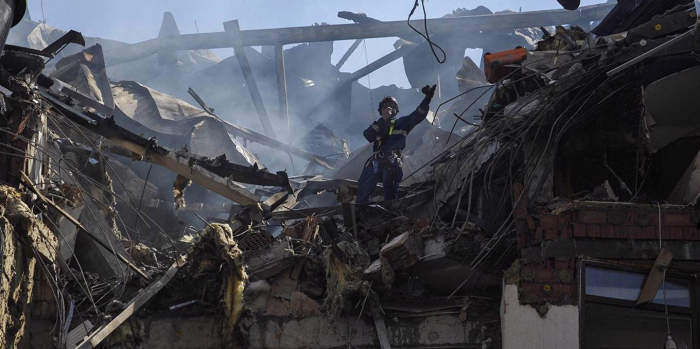Without security guarantees, it is difficult to imagine Ukraine experiencing the kind of economic transformation previously seen elsewhere in Eastern Europe. With such guarantees in place, firms’ participation in value chains could make the country more prosperous, Europe more efficient, and the world better fed.
The conflict in Ukraine drags bloodily on, but it is not too soon to start planning for the country’s postwar recovery. This is important not just because planning takes time, but also because it informs what kind of peace will be required to give Ukraine a path to prosperity.
Some think that Russia will never accept a solution where Ukraine is anything other than a buffer state. But such an outcome would entail gigantic economic costs that would condemn Ukraine to a future of misery. After all, a buffer state is precisely what Ukraine was following the Soviet Union’s collapse in 1991, and the results were disastrous, triggering both the 2004 Orange Revolution and the Maidan Revolution a decade later.
The statistics are quite staggering. According to the World Bank, Ukraine’s income per capita declined by half between 1990 and 1998, the third-largest collapse (after those of Tajikistan and Moldova) among the former communist states of Eastern Europe and Central Asia. Moreover, Ukraine experienced the slowest recovery of all the states that formerly comprised the Soviet bloc.
In 1990, Ukraine’s income per capita was 28% higher than Poland’s and 42% higher than Romania’s. By 2003, on the eve of the Orange Revolution, it was 25% lower than Romania’s and 54% lower than that of Poland. In 2013, before the Maidan Revolution and Russia’s annexation of Crimea, it was 46% below Romania’s and 56% below Poland’s. By 2019, the last full year before the outbreak of the COVID-19 pandemic, Ukraine’s income per capita gap relative to both Poland and Romania had widened to 58%.
Ukraine’s dismal performance was the result of two factors: its insufficient integration with the West, and the post-2014 conflict with Russia, which was itself caused in part by Ukraine’s desire to move closer to the West.
Ukraine’s deep economic ties to Russia date back to Soviet times. The country’s most sophisticated exports – including electrical transformers, vacuum pumps, rail rolling stock, and vehicles – were linked to Russian value chains, while its exports to the West were concentrated in less complex products such as agricultural commodities, garments, and electrical wire. When Russia recovered after 2004 on the back of its oil and gas exports, its manufacturing industries lagged behind, which goes some way toward explaining Ukraine’s underperformance.
After Russia’s 2014 invasion of Crimea and the ensuing war in eastern Ukraine’s Donbas region, Ukrainian exports to Russia collapsed. Ukraine was unable to sell these advanced industrial goods elsewhere, because these products need to be tailor-made for the customer, which requires long-term contracts, technology transfer, and stable value chains that rely on a deep and durable integration framework, like that provided by the European Union.
As a result, while the EU’s imports of the same kinds of products that Ukraine was selling to Russia boomed in this period, Ukraine was not able to participate in this growth. In fact, Germany’s imports from Ukraine in 2019 were barely above their 2011 levels, while its imports from Romania, Poland, and elsewhere in the EU were surging.
This was not because Ukraine had less manufacturing competence and expertise than Poland and Romania. Quite the contrary: It had a much deeper tradition of advanced manufacturing than either of these countries. Work by Frank Neffke of the Complexity Science Hub in Vienna, and Matte Hartog and Yang Li of the Harvard Growth Lab shows that the Ukrainian economy’s center of gravity moved east between 1990 and 2003 and has since been moving west.
But Ukraine’s westward economic shift was very slow because of low levels of foreign direct investment, especially from the EU. While employment in foreign firms in 2019 represented 6.9% and 9.3% of total employment in Poland and Romania, respectively, it amounted to only 1.9% of the total in Ukraine.
This poor FDI performance reflected the absence of two things: a security umbrella to protect investments in Ukraine from post-2014 Russian aggression; and deep integration agreements with the EU, which are critical for trade based on value chains.
The second of these preconditions seems to be in the cards in light of the EU’s recent decision to grant Ukraine candidate status, following a June 16 visit to Kyiv by French President Emmanuel Macron, German Chancellor Olaf Scholz, and Italian Prime Minister Mario Draghi. But, without security guarantees, it is difficult to imagine Ukraine experiencing the kind of economic transformation we have seen elsewhere in Eastern Europe. Firms will not want to rely on value chains that have a high risk of being destroyed by Russia.
Supposed foreign-policy “realists” like John Mearsheimer blame the Ukraine war on NATO’s eastward enlargement. If anything, the opposite is true: Ukraine was attacked because it was not part of a defensive military alliance. Security guarantees are needed to generate participation in value chains that could make Ukraine more prosperous, Europe more efficient, and the world better fed.
Ricardo Hausmann, a former minister of planning of Venezuela and former chief economist at the Inter-American Development Bank, is a professor at Harvard's John F. Kennedy School of Government and Director of the Harvard Growth Lab.
More about:
















































